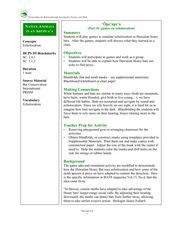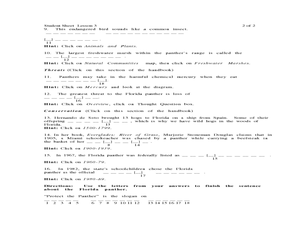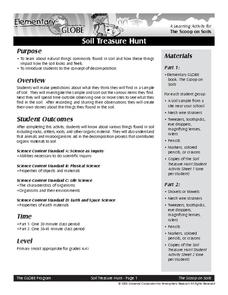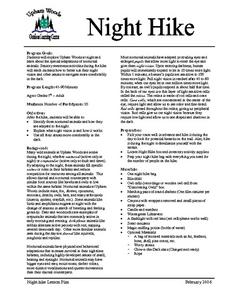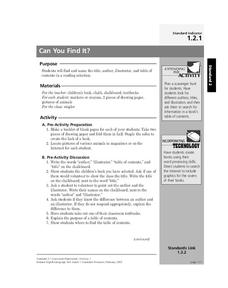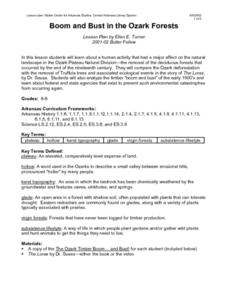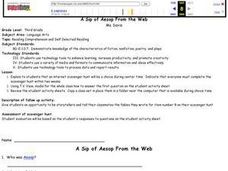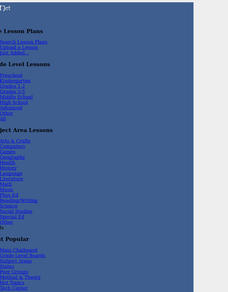Curated OER
Language Arts: Scavenger Word Hunt
Participate in a scavenger hunt to find objects beginning with a particular letter sound and take digital photos of them with your scholars. Using software, they find word pictures beginning with particular letters and locate picture...
Curated OER
Going on a Bear Hunt
Students investigate pantomiming by going on a fictitious bear hunt. In this performing arts instructional activity, students collaborate in groups to sing songs and perform pantomimes based on a hunting trip. Students create...
Curated OER
Internet Animal Scavenger Hunt
In this Internet animal scavenger hunt worksheet, students do research online to answer 10 essay questions about animals. No specific site suggestions are given.
Curated OER
Internet Scavenger Hunt
Students use a computer and the internet to click on highlighted words to find certain answers. They then write the answer to the questions on paper. Finally, students choose one animal to write about. They research the animal on the...
Curated OER
Games on Echolocation
Get a little batty with life science! This fun simulation game replicates how bats use echolocation to hunt moths in their native Hawaiian habitat. After creating blind folds and discussing some basic principles of echolocation, young...
Curated OER
Panther Scavenger Hunt
Students research a website to learn about the Florida panther. In this animal research lesson, students use the scavenger hunt directions to search a website about Florida panthers. Students also solve word puzzles within the activity.
Curated OER
Soil Treasure Hunt
Students explore the concept of soil and decomposition. In this soil and decomposition lesson, students investigate bags of soil. Students then learn how animals and other organisms help in the decomposition process.
Curated OER
Wappo Indians: Animals They Hunted
Third graders examine the hunting and foraging practices of the Wappo tribe. They discover Wappo words for food and determine which animals still live in Napa County. They research the diet, habits and homes of these animals.
Curated OER
Scavenger Hunt! Exploring the Prairie
Young scholars participate in an online scavenger hunt activity, researching the type of housing pioneers built to match the natural environment. They design and create a poster exhibit or Web page presenting information about pioneer...
Curated OER
A Dinosaur Scavenger Hunt
Students explain what a fossil is, learn six dinosaurs and tell one characteristic about each, then describe verbally what a dinosaur might have looked like.
University of Kentucky
Beneficial Bug Scavenger Hunt
Many people think of bugs as annoying pests to be squashed, but most insects and spiders are beneficial, eating the actual pests or pollinating plants. After reviewing some of the common bugs in your area (they may differ from those...
Curated OER
Night Hike
Students explore Upham Woods at night and investigate about the special adaptations of nocturnal animals. They identify three nocturnal animals and how they are adapted to the night. Students explain what night vision is and how it works.
Out of Africa Wildlife Park
A Thematic Learning Guide to Lions
Written as an accompaniment to a field trip to the Out of Africa Wildlife Park in Arizona, this is an interdisciplinary, themed lesson on lions. Even if you cannot take your upper-elementary kids to this attraction, there are a few...
Curated OER
Habitats of the World
Students discover that the Earth supports many different animal habitats. In this habitat lesson students research different habitats of the world. Students show how the animals in their habitat are adapted.
Curated OER
Can You Find It?
Plan a Parts of a Book scavenger hunt. Begin by giving your young adventurers a book, and asking them to find the title, author, illustrator, and table of contents. After a discussion of the purpose of each of these items, class members...
Curated OER
Boom and Bust in the Ozark Forests
Here is a hard-hitting, cross-curricular lesson on the effects that the deforestation of the Ozark forests in the 19th century had on the people, animals, and ecosystems of the area. The Dr. Seuss book The Lorax is used as a way of...
Curated OER
ABC and 1-2-3 Farming
Students demonstrate how to alphabetize animal names. In this word study activity, students identify animals that live on the farm and conduct a favorite farm animal survey. Students order animal pictures in alphabetical order.
Curated OER
The Very Busy Spider
Learners read the story The Very Busy Spider and go on a spider hunt, complete a KWL chart, talk about the animals in the book, and more. In this guided reading lesson plan, students take 5 days to read the book.
Curated OER
A Hunting We Will Go
Students navigate the Internet to research online encyclopedias and answer questions. In this navigating the net activity, students answers questions and compare their answers. Students discuss information gathered and the sources....
Curated OER
Biodiversity Bird Hunt
Learners examine the influence of biodiversity on human culture through the use of birds. They brainstorm words that come to mind when they think of human cultures. They describe ways that human culture and biodiversity are linked.
Curated OER
A Sip of Aesop From the Web
Third graders answer specific questions by conducting an Internet scavenger hunt. They write their own fable after reading many different fables on the Internet. They questions that they answer are included in this lesson.
Curated OER
An Uncertain Future
Students study the distribution of large mammals and carnivores in an ecosystem. Using maps and historical data, they examine areas for these animals such as refuges, untouched forests, prairies and grasslands. Students determine actions...
Curated OER
How Do Species Become Extinct?
Students examine reasons that animals become extinct. They participate in a simulation to discover that animals loss of home is the main factor that puts species near extinction in North America. Students examine over-hunting and...
Curated OER
Figurative Language Scavenger Hunt
Eighth graders analyze and interpret figurative language. They listen to some examples of poetry which use figurative language. Then, they divide into groups and attempt to find more examples. Finally, 8th graders write what the poet is...






